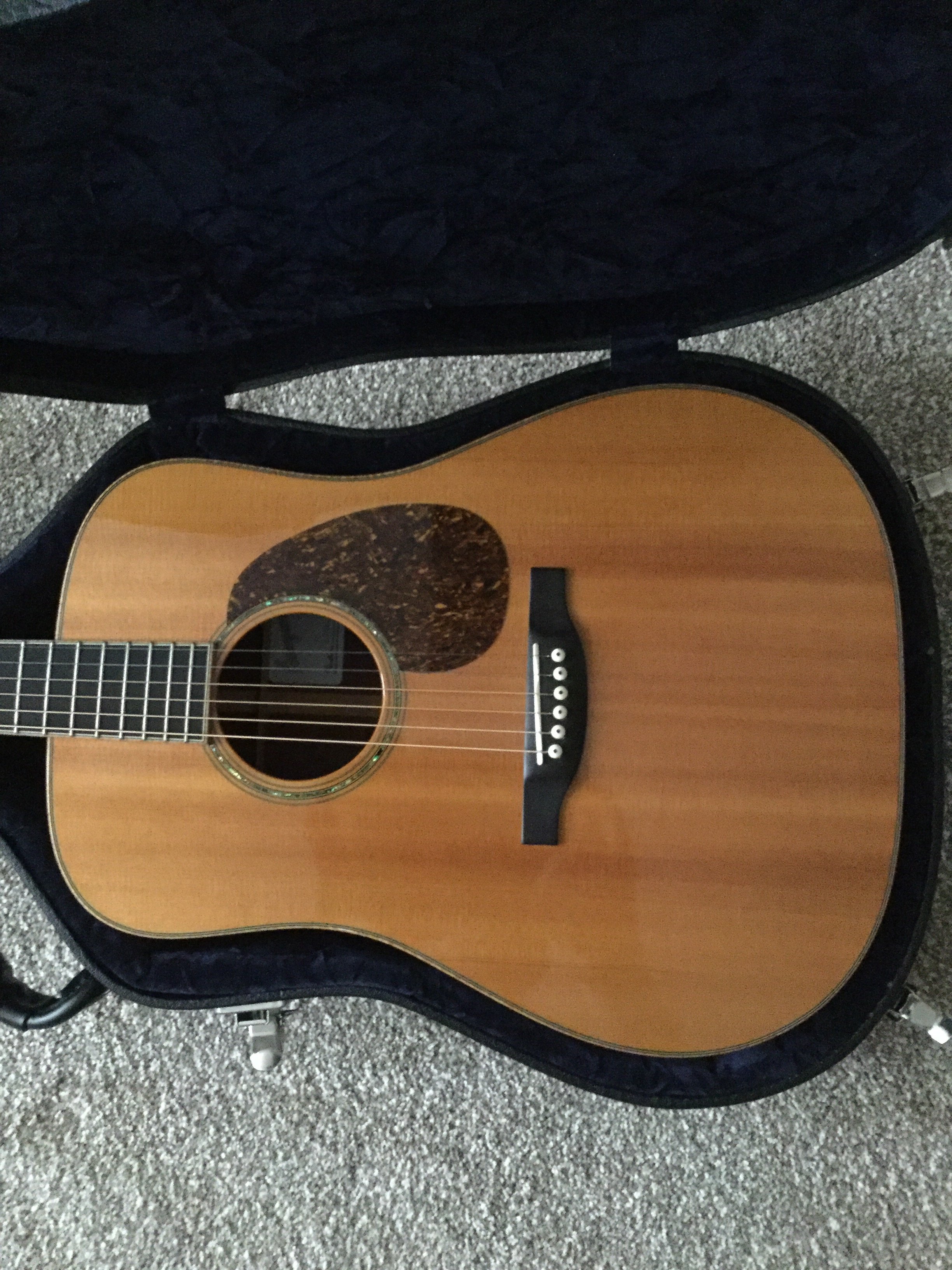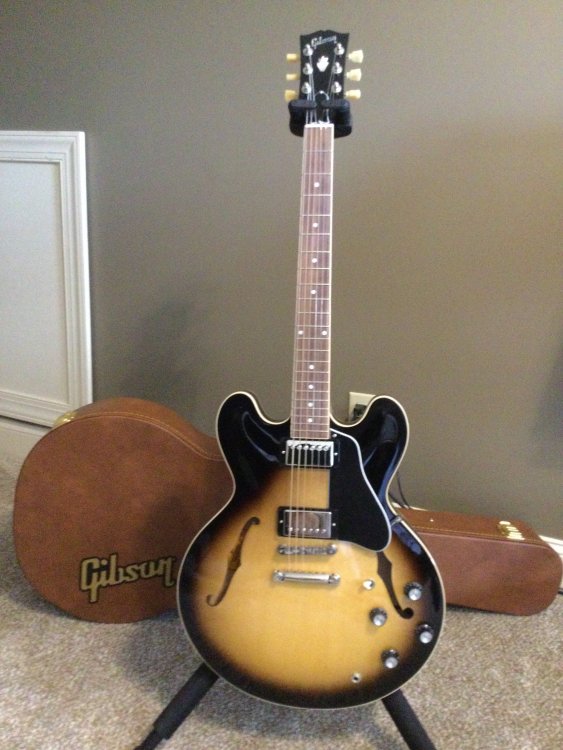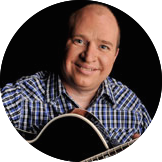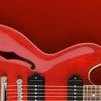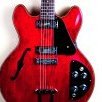-
Posts
121 -
Joined
-
Last visited
-
Days Won
27
Content Type
Profiles
Forums
Gallery
Events
Articles
Blogs
Downloads
Everything posted by Gary Nelson
-
Thanks for all the well wishes. One thing I will say - regardless of the name on the headstock, this thing would benefit from a setup! Definitely not intonated properly. As this is my first Gibson with the ABR bridge, I have some questions before I jump in. Unfortunately I can't get to Nashville to let Greg and his team at Gruhn's work their magic, so I thought I would try Gibson's Virtual Guitar Tech to get some questions answered. I'll let you all know how that goes.
-
Fretless, we may both have second thoughts when the credit card bill arrives!
-
I’ve had an ES335 or similar on my wish list for a while now. I’ve been keeping my eye out for a decent used one, but wasn’t willing to pay a “vintage” price. While in Memphis the other day, I dropped into Guitar Center to just see if they perhaps had an Epiphone I could try. They did have a couple, but also had this one Gibson hanging on the wall. After giving it a try, I decided this was it. So after a bit of indecision, I decided (with my wife’s approval and encouragement) to go ahead and bite the bullet. I’m telling myself that this one now completes my collection - but we all know better! I don’t think it has made me a better player, but my mistakes sure sound nice!
-
@Colburn - Steve just confirmed that it is a typo. Should be corrected in the new version of the handout. Good catch!
-
Sorry for misunderstanding the question Colburn. Now that I take the time to actually look at the handout I see what you are talking about. I'm almost thinking this may be a typo - perhaps this was intended to be a 4th finger exercise which would put your first finger in the second fret. Sounds like a good question for Steve tonight!
-
Hi @Colburn. The examples that Steve provided in the workout were in the key of C. There were several forms for arpeggios beginning on the 6th string, depending on which finger was used on the root of the chord. So for example, his first Practice and Learn Challenge is asking us to transpose what we learned in the key of C to an A Major. With the Root on the 1st finger, (the A on the 6th string 5th fret) you can refer back to the example on page 4 showing how he would play the arpeggio beginning C at the 8th fret. So you would just move your hand back up the neck to the 5th fret and basically play the same pattern. For the root on the 2nd finger, 4th position, you can use his first example on pages 2-3. Remember, the number with the diamond denotes the root of the chord. Hope this helps!
-
Diane - thanks for sharing. It would be great if we all had a "neighbor Don" to enjoy playing with, but more importantly to re-introduce us to some of these old songs that all too often find their way into the the recycling bin.
-
Very cool Greg! Glad we got to meet in Nashville this year. Looking forward to seeing you next year.
-
@Prabhu Thankfully, I've never experienced any issues with truss rod adjustments on any of my guitars. Assuming the truss rod is functioning correctly, too much relief in the neck can be corrected by tightening the truss rod (but I'm sure I'm just restating the obvious). Seems you are doing the right thing by taking it to a luthier, although I'm not sure how he or she decided the truss rod was working properly, if it was having no impact on the neck. I think I would seek a second opinion from a another qualified luthier or if the guitar is new, contact their customer support. In the meantime, these tips came from the Sweetwater site - not sure how helpful they will be, but things to keep in mind. Best of luck to you! When adjusting your neck, remember these tips! Don’t adjust too much at once. You’ll want to turn the truss rod about a ¼ of a turn at a time until you’re familiar with how your truss rod will react. Always re-tune the guitar before checking your adjustment. Don’t force anything. If you feel excessive resistance during an adjustment, your truss rod could be maxed out. Further adjustment could damage the instrument. An inspection by an experienced technician is recommended. If you feel that you’re loosening the truss rod and it isn’t making any adjustment, you may have a dual-action truss rod. Check your instrument’s specifications. If you do, your truss rod will eventually catch and you’ll be able to make the proper adjustment. Some necks will not adjust right away. In some cases, it’s better to make adjustments and let the neck settle overnight to ensure you don’t over-adjust.
-

News from the 2021 Gathering
Gary Nelson replied to DianeB's topic in Guitar Gathering Conferences & Retreats
All the posts and pics make me "homesick". Already looking forward to June 15 next year! -

14 Best Beginner Guitar Amps of 2021
Gary Nelson replied to Randy120's topic in Guitar Gear, Amps, Effects, Pedals
I'll be the first to admit, I don't have a lot of experience with different amps, but I'm in the Boss Katana camp as well. I chose one as my first amp and so far, it does everything I need it to do, but I'm sure at some point I may want to try a tube amp. -

Guitar Gathering 2021?
Gary Nelson replied to Sonicfreq's topic in Guitar Gathering Conferences & Retreats
Thanks Diane. Really looking forward to it, although I am a bit bummed to hear that there will be no NAMM visit on Saturday. Guess I will have to satisfy my new gear urges with a trip to Gruhn's or the new Gibson Garage. Just a quick note about the hotel. I called on Monday of this week (June 7) to make a reservation and was told there were no more rooms in our GGC block. However, they did have rooms available and agreed to honor our negotiated rate. But it might be necessary to call and make the reservation as opposed to using the website. Hope to see everyone in July! -
Definitely on my list to visit while I am in Nashville for the Gathering (unless I get impatient and drive up ahead of time).
-
I'm not sure if this applies to your situation, but it has bitten be before. If your preamp has a built in tuner, make sure the tuner is not turned on. This can disengage the preamp. I know this is the case on my Fishman preamp in one of my acoustics. Just food for thought - when I put a pickup in my Bourgeois, I did not want to bother with a battery. I opted for a K&K Pure Mini passive pickup. This can be routed through an external preamp which is a bit easier to deal with battery changes.
-
@arju I tend to agree with the points @matonanjin raised. I was one of those that went through the L&M course quickly - much too quickly. I have a bit of music background, having played in school bands and choirs - but different instruments. Then, after going through the course, I realized quickly that while I had gained familiarity with the concepts, I certainly had not learned it and definitely had not achieved any level close to mastery. So I went through it again and focused more intensely on areas that I struggled with. Even now, after having been through the Fingerstyle course, I still go back to the L&M course to reinforce certain concepts that still challenge me. So the opinion of this geezer is to not rush through the course and measure your success by your enjoyment of playing, and not by a pre-defined time limit.
-

Steel Strings for Acoustic
Gary Nelson replied to InpulseArts's topic in Guitar Gear, Amps, Effects, Pedals
I've used D'Addario Phosphor Bronze EXP-17 Mediums (.013-.056) on my Bourgeois. I think that is what they are strung with at the factory. But lately I've dropped to Elixir Nanoweb Phosphor Bronze Lights (.012 - .053) -

Laminate vs Solid wood acoustic guitars
Gary Nelson replied to Nairon's topic in Guitar Gear, Amps, Effects, Pedals
Nairon, I'll second what Randy and Plantsman13 have said. Solid wood guitars are generally viewed as superior, although the sound and playablility ultimately depend on the type and quality of wood used, the quality of construction and numerous other factors. Lower priced guitars are getting better and many lower priced guitars these days feature at least a solid top and some such as Epiphone's new Inspired by Gibson line advertise all solid wood. My "nice" guitar is all solid mahogany with a Spruce top and it certainly has a great sound. But the guitar that I generally grab for practice and general "noodling" is my first student guitar - a Fender CD-60 with all laminate construction. Take Plantsman's advice and make sure whatever guitar you choose is one you enjoy playing and suites the style of music you want to play, has a decent setup to make it more playable and fits your budget. And yes, if you have a choice of solid wood or laminate - I'd go solid. -

Anybody Here Planning on Snagging This?
Gary Nelson replied to Dave White's topic in Guitar Gear, Amps, Effects, Pedals
Sure Dave. I’ll just send you a check. It will be the perfect match for the 450k Sweet Home Alabama Strat that is available at Carter Vintage Guitars in Nashville. 😂 -
Thanks @DianeB. I figured I could count on you to set me straight. Seems everything I was finding online was close - but no cigar! Life was sure simpler when I was just playing C, D and G!😉
-
Hey guys - Hopefully a quick confirmation about the chords you would play in a relative minor key. I went back through the How Music Works materials we got from Steve last year and didn't really see this concept spelled out. And naturally, I am finding conflicting information on different internet sites. As we know, the chords in a major key follow a certain pattern. Using C Major as an easy example we would play C, Dm ,Em, F, G, Am, Bdim. But when playing chords in A minor, am I correct that you would play the same chords - just in a different sequence - Am, Bdim, C, Dm, Em, F, G? I have seen some internet sites that suggest the 5 chord in a minor key is played as the major chord - so in this example the Em would be played as E. I'm sure our "crazy nuts" can point me in the right direction!
-
Hi @cdevaux It's been a while since I went through that part of the Fingerstyle course so I don't recall exactly what Steve demonstrated on the DVD. But I recall a few instances in the course where the tab differs a bit from what Steve plays on the DVD - I think the tabs were created later on. I had a lesson with Steve when I was going through this song, and he said that basically either fingering is correct, but playing the B at the 12th fret allows you to keep the same finger shape as in the first measure - all you do is slide up to the 12th fret. To me that fingering was much easier than trying to play the B at the 7th fret E string. The picking pattern remains the same. His other advice for this song is to really focus first on playing the main chords of the song first, and not get hung up on trying to play that lick.
-

Guitar Gathering 2021?
Gary Nelson replied to Sonicfreq's topic in Guitar Gathering Conferences & Retreats
Same plan as @Dave White. I've never been to a NAMM before, so very excited about the opportunity to put my hands on some of the instruments I am considering. But I am cheating - I only live 2 hours away and will be staying with my son who lives in Nashville! -
Thanks Mike and Randy for the feedback. Yes, you get all sorts of opinions on the discussion boards. Glad that we have this forum to share some first hand experiences.
-
Just wondering if anyone has any experience with pinless bridges, such as those used by Takamine or Breedlove on some of their guitars. I'm considering a Takamine 12 string with a pinless bridge and curious about the durability of these types of bridges, particularly with the added pressure of 6 extra strings. Or if I need to stick with a more traditional pinned bridge.
-
I'm in the same camp as @David White. I tried out a few of the pure classical models from Cordoba, but I wasn't really able to find one that had the sound of the feel I was hoping for. I ended up selecting an Alvarez hybrid model although several manufacturers now offer similar styles with the slightly narrower nut, slightly radiused fretboard, 14 fret neck and a cutaway. This model has the traditional fan bracing like a pure classical. I got it specifically to complete the Classical section of the Fingerstyle course and I truly enjoy it. I'm finding it to be one of my "go to" guitars now.

